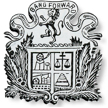Johnstone History Museum
Johnstone History Society • Scotland
World War II |
February 9, 2018 |
Rudolf Hess - The Johnstone Connection
February 9, 2018
The story of Rudolf Hess landing by parachute at Floors Farm Eaglesham, Renfrewshire on 10th May 1941 is well known including his capture by the farmer David McLean and his subsequent handover to the 3rd Renfrewshire Home Guard, who took him to their HQ in Busby (now the Masonic Hall). From there he was transferred to the HQ of the Home Guard in the Scout Hall at Florence Drive. Giffnock for interrogation. He gave the name Alfred Horn, a Hauptmann (Captain) in the Luftwaffe and stated that he had an important message for the Duke of Hamilton.
The first person to recognise him as Hess, the Deputy Fuhrer of Germany was Captain Graham Donald DFC, who had been on duty that night with 34 Group, Royal Observer Corps, in their HQ at New Temperance House, Pitt Street, Glasgow and had followed the course of the plane and attended at Giffnock.
Donald was a Johnstone man being the son of David Patrick Donald, Greenbank, William St., Johnstone, the main partner in the firm of Craig and Donald, Machine Tool Company. During WW1 Graham Donald was a fighter pilot in the Royal Naval Air Service, seeing action at Jutland in 1916. He later served on the Struma Front and the Dardanelles shooting down Turkish and German planes for which he was awarded the DFC and the Hellenic War Cross. He joined the RAF on 1st April 1918 on formation of that service. Donald passed on the message to the Duke of Hamilton that Hess wanted to see him.
Also in attendance that night was Inspector Thomas Broadfoot Hyslop, Renfrewshire Constabulary, who wrote a report on the incident. A native of Dumfries-shire he joined the Johnstone Burgh Police in 1912, rising to the rank of Sergeant. He resided at The Cottage, 14 Hagg Rd., Johnstone and in 1930 he transferred on amalgamation of the force into the County Force. He continued in Johnstone until 1934 when he was promoted Inspector and transferred to Giffnock.
Hess of course was incarcerated in Britain for the rest of the war. He was thereafter escorted to Nuremberg by Lieut. Colonel Arthur James Barriston Larcombe for trial. This is thought to be the same Col. Larcombe who took over command of the German POW Camp No 188 at Johnstone Castle from Lieut. Col. Christopher Gerald Stephen in 1946
The first person to recognise him as Hess, the Deputy Fuhrer of Germany was Captain Graham Donald DFC, who had been on duty that night with 34 Group, Royal Observer Corps, in their HQ at New Temperance House, Pitt Street, Glasgow and had followed the course of the plane and attended at Giffnock.
Donald was a Johnstone man being the son of David Patrick Donald, Greenbank, William St., Johnstone, the main partner in the firm of Craig and Donald, Machine Tool Company. During WW1 Graham Donald was a fighter pilot in the Royal Naval Air Service, seeing action at Jutland in 1916. He later served on the Struma Front and the Dardanelles shooting down Turkish and German planes for which he was awarded the DFC and the Hellenic War Cross. He joined the RAF on 1st April 1918 on formation of that service. Donald passed on the message to the Duke of Hamilton that Hess wanted to see him.
Also in attendance that night was Inspector Thomas Broadfoot Hyslop, Renfrewshire Constabulary, who wrote a report on the incident. A native of Dumfries-shire he joined the Johnstone Burgh Police in 1912, rising to the rank of Sergeant. He resided at The Cottage, 14 Hagg Rd., Johnstone and in 1930 he transferred on amalgamation of the force into the County Force. He continued in Johnstone until 1934 when he was promoted Inspector and transferred to Giffnock.
Hess of course was incarcerated in Britain for the rest of the war. He was thereafter escorted to Nuremberg by Lieut. Colonel Arthur James Barriston Larcombe for trial. This is thought to be the same Col. Larcombe who took over command of the German POW Camp No 188 at Johnstone Castle from Lieut. Col. Christopher Gerald Stephen in 1946
